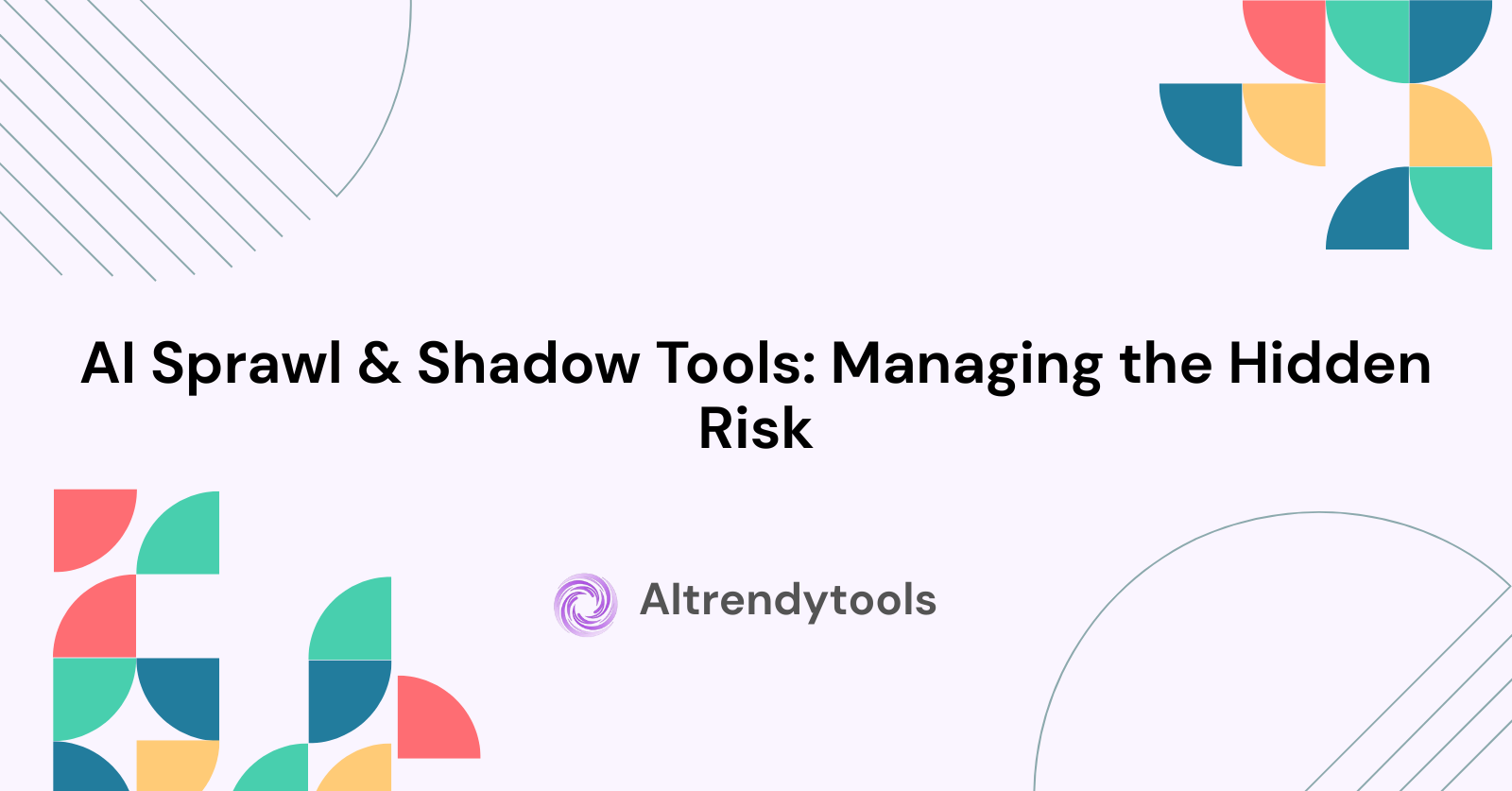🔥 AITrendytools: The Fastest-Growing AI Platform |
Write for usAI Sprawl & Shadow Tools: Managing the Hidden Risk
Shadow AI tools expose sensitive data. Discover enterprise strategies to manage AI sprawl, prevent security breaches, and enable safe innovation
Oct 16, 2025
AI Sprawl & Shadow Tools:
The workplace transformation happening right now goes beyond simple technology upgrades. Employees are three times more likely to use generative AI for significant portions of their work than leadership realizes. This gap reveals a concerning trend where unauthorized AI tools proliferate without proper oversight. Organizations face mounting pressure as workers independently adopt AI solutions to enhance productivity. The convenience of these tools creates blind spots in security infrastructure. Research shows that 98% of employees use unsanctioned applications across shadow AI and shadow IT categories.
What Is Shadow AI
Shadow AI represents the unauthorized deployment of artificial intelligence tools within organizational environments. Employees share sensitive work information with AI tools without employer permission at alarming rates, with 38% acknowledging this practice. The distinction from traditional shadow IT lies in how AI models process and potentially expose information.
Workers turn to these unauthorized solutions for legitimate reasons. They seek efficiency improvements and workflow automation. Only 16% of employees strongly agree that organization-provided AI tools prove useful for their work. This dissatisfaction drives the adoption of unsanctioned alternatives. The accessibility of AI platforms accelerates this trend. Free and low-cost tools enable workers to integrate advanced capabilities without technical expertise.
Common shadow AI tools employees use without approval:
- ChatGPT for writing emails and reports
- Claude for document summarization
- Meeting transcription AI services
- Code completion assistants
- AI-powered design tools
- Automated data analysis platforms
Understanding AI Sprawl in Organizations
AI sprawl occurs when multiple artificial intelligence tools and applications proliferate throughout an organization without centralized oversight. Companies discover an average of 15 new applications per month, with hundreds remaining hidden across various channels including SSO logs, email signups, and browser extensions. The phenomenon extends beyond simple application multiplication. Each unauthorized tool introduces unique security vulnerabilities and compliance challenges.
The rapid pace of AI innovation compounds the problem. New solutions emerge constantly, tempting employees to experiment. Technology and professional services sectors report the highest AI usage rates at 50% and 34% respectively. Business units increasingly control their own software spending. This decentralization makes tracking AI adoption nearly impossible. IT departments discover tools only after they become embedded in workflows.
Data Security Risks From Unauthorized AI Tools
Unauthorized AI adoption creates severe data exposure vulnerabilities. Multiple Samsung employees pasted proprietary code lines into ChatGPT to streamline work, inadvertently exposing confidential information. Such incidents demonstrate how seemingly innocent actions lead to significant breaches. The training data concerns amplify these risks. Many AI platforms incorporate user interactions into their learning models. Sensitive information becomes part of publicly accessible systems.
Employees often lack awareness of these implications. They focus on immediate productivity gains rather than security consequences. Research indicates that 38% of surveyed employees share confidential data with AI platforms without approval. The model training opt-out features frequently go unnoticed. Default settings may allow data collection. Workers rarely review privacy policies or understand data handling practices of third-party AI services.
Types of data at risk from shadow AI:
- Customer contracts and pricing information
- Proprietary source code and algorithms
- Strategic business plans and forecasts
- Employee personal information
- Financial records and projections
- Partner and vendor confidential data
Compliance Violations and Regulatory Challenges
Regulatory frameworks struggle to address AI-specific challenges. Shadow AI sidesteps compliance frameworks including GDPR, HIPAA, SOC 2, PCI DSS, and CCPA entirely. The consequences reach far beyond simple violations. GDPR violations carry penalties reaching 4% of global revenue. Healthcare organizations face massive fines for HIPAA breaches. Financial services companies risk losing enterprise customers and millions in damages.
The unpredictability of AI outputs creates additional compliance headaches. Statistical pattern-based decisions lack clear justification pathways. Organizations cannot explain or defend AI-driven choices in regulatory reviews. Industry-specific regulations add complexity. Healthcare data requires special handling. Financial information demands strict access controls. Educational records have unique protection requirements. Shadow AI tools typically ignore these distinctions.
Key compliance risks from unmanaged AI:
- Data residency violations
- Inadequate access controls
- Missing audit trails
- Unauthorized data processing
- Failure to honor data subject rights
- Cross-border data transfer issues
The Hidden Costs of Unmanaged AI Adoption
Financial implications of AI sprawl extend beyond direct security breaches. Companies end up with sanctioned but overbought applications where licenses go unused as people migrate to other tools. This represents pure waste in technology spending. Redundant tools create operational inefficiencies. Multiple teams might pay for similar capabilities independently. Finance departments struggle to track distributed AI spending across business units.
The productivity paradox emerges when too many tools compete for attention. Workers waste time switching between platforms. Learning curves multiply with each new application. Integration challenges prevent seamless workflows. Reputational damage from AI incidents carries immense costs. Customer trust erodes after data breaches. Brand value diminishes when AI generates problematic outputs.
AI Model Training Data Concerns
The data feeding AI models determines output quality and safety. Sensitive information could become part of model training data, moving from inside the company to the public domain on a broad scale. This transformation creates irreversible exposure. Proprietary algorithms face particular vulnerability. Development teams might seek AI assistance with code optimization. Strategic documents get summarized through unauthorized tools.
The transparency gap makes risk assessment difficult. Organizations cannot verify what happens to submitted data. Third-party providers may have unclear data handling practices. Terms of service often include broad usage rights that few users read. Intellectual property protection becomes impossible once information enters external systems. Patents pending disclosure could invalidate applications. Trade secrets lose legal protection.
Critical data exposure pathways:
- Direct text input into AI chat interfaces
- File uploads for analysis or processing
- API integrations with business systems
- Browser extensions with content access
- Email plugins analyzing message content
- Screenshot tools with OCR capabilities
Biased Outputs and Decision-Making Issues
AI systems inherit biases from their training data and design choices. Unauthorized AI-driven resume screening tools could introduce hidden biases leading to discrimination lawsuits. Organizations bear responsibility for outcomes they cannot predict or justify. The probabilistic nature of AI decisions complicates accountability. Models make educated guesses based on statistical patterns.
Hiring practices face particular scrutiny. Screening tools might systematically exclude qualified candidates. Promotion algorithms could perpetuate historical inequities. Compensation analysis might reflect societal biases rather than merit. Customer interactions suffer from biased AI responses. Chatbots might provide inconsistent service quality across demographics. Recommendation systems could reinforce stereotypes.
Employee Productivity vs Security Trade-offs
Workers adopt unauthorized AI tools for genuine efficiency gains. ChatGPT users report saving 1.5 to 2.5 hours weekly through streamlined writing and problem-solving tasks. These productivity improvements explain the appeal despite security risks. The time savings span multiple functions. Email drafting becomes faster. Meeting notes get summarized automatically. Reports generate with minimal effort.
Security teams face pushback when restricting useful tools. Employees perceive bans as obstacles to productivity. Banning AI outright can backfire, pushing users toward unauthorized tools and stifling innovation. The enforcement challenge grows with resistance. The competitive pressure intensifies adoption urgency. Teams worry about falling behind rivals using AI. Individual workers fear appearing less productive than peers.
Why employees bypass official channels:
- Approved tools lack needed features
- Request processes take too long
- No suitable alternatives exist
- Peer pressure to keep pace
- Unclear approval procedures
- Limited tool awareness
Why Traditional IT Management Falls Short
Conventional IT governance approaches prove inadequate for AI oversight challenges. Most traditional IT management tools and processes lack comprehensive visibility and control over AI applications. The technology evolves too rapidly for standard procedures. Legacy security systems cannot detect AI-specific threats. Data loss prevention tools miss context around AI interactions.
The approval processes move too slowly for business needs. Leaders report that 56% of generative AI projects take 6 to 18 months moving from intake to production. Frustrated teams bypass official channels rather than wait. Procurement cycles cannot keep pace with AI innovation. New tools emerge constantly. Evaluation criteria struggle to capture AI-specific risks. By the time approval completes, better alternatives exist.
Enterprise AI Governance Best Practices
Successful AI governance requires moving beyond prohibition toward partnership. Organizations need clear policies defining approved tools and usage parameters. Organizations can establish AI Acceptable Use Policies specifying data handling enforcement mechanisms. Employees should understand what data types can and cannot enter AI tools. Centralized AI governance provides essential oversight like other IT governance practices.
The internal AI marketplace approach offers controlled access. Organizations can feature approved tools on allow-lists. Employees gain access to safe, enterprise-sanctioned solutions. IT maintains visibility while enabling innovation. Risk classification systems help prioritize oversight efforts. Tools get categorized as Approved, Limited-Use, or Prohibited. High-risk applications receive closer scrutiny.
Essential governance framework components:
- Executive sponsorship and accountability
- Cross-functional governance committee
- Clear policies and procedures
- Approved tool catalog
- Risk assessment methodology
- Continuous monitoring system
- Employee training program
- Incident response plan
Building an AI Acceptable Use Policy
Effective policies balance security requirements with practical usability. Organizations should document approved AI tools clearly. Usage guidelines need specific examples rather than vague principles. Data classification frameworks help employees make informed decisions. Policies should define public, internal, confidential, and restricted information categories. Clear guidance prevents accidental exposure of sensitive materials.
The approval process needs reasonable timeframes. Fast-track options for low-risk tools encourage compliance. Emergency provisions address urgent business needs. Transparent criteria help teams understand evaluation standards. Training programs ensure policy awareness and understanding. Organizations should teach employees how AI works, including risks, responsible use and best practices.
Key policy elements to include:
- Permitted AI use cases by department
- Data classification and handling rules
- Required approval workflows
- Security and privacy requirements
- Monitoring and audit procedures
- Violation consequences and remediation
- Regular policy review schedule
Creating Approved AI Tool Catalogs
Internal AI marketplaces solve the shadow AI problem through positive alternatives. Organizations can curate collections of vetted tools. Employees get access to capable solutions without security risks. The selection process should involve stakeholder input. IT security provides risk assessment. Business units identify functional requirements. Procurement handles licensing and contracts.
Integration with existing systems improves adoption. Single sign-on simplifies access. Directory services manage permissions. Usage analytics track adoption patterns. Support resources help employees maximize value. Regular catalog updates maintain relevance. New tools get evaluated continuously. Outdated applications get retired. User feedback guides improvement priorities.
Employee Training and Awareness Programs
Education transforms AI governance from rules into culture. Organizations should explain the reasoning behind policies. Employees who understand risks make better decisions independently. Role-based training addresses specific job functions. Developers need different guidance than marketers. Finance teams have unique compliance requirements. Customer service representatives face distinct challenges.
Practical scenarios prove more effective than abstract principles. Training should include real examples from the organization's context. Case studies demonstrate consequences. Hands-on exercises build skills. The AI sandbox concept enables safe experimentation. Organizations can create AI sandboxes where employees test AI tools in controlled environments. Controlled settings prevent production system impacts while supporting learning.
Effective training program elements:
- Interactive workshops and simulations
- Real-world case studies
- Department-specific scenarios
- Hands-on sandbox environments
- Regular refresher courses
- Certification programs
- Quick reference guides
- On-demand video tutorials
Implementing AI-Specific Data Loss Prevention
Standard DLP solutions require AI-focused enhancements. Organizations need inspection capabilities for AI interactions. AI-specific Data Loss Prevention tools act as gatekeepers by inspecting and filtering sensitive information before it leaks. These measures ensure compliance and prevent exposure. Context-aware filtering improves effectiveness. Systems should understand AI-specific data flows.
Real-time intervention prevents damage before it occurs. Alerts notify users of policy violations immediately. Blocking mechanisms stop prohibited data transmission. Alternative suggestions guide users toward compliant approaches. Integration with classification systems enables smart enforcement. Automatically tagged data triggers appropriate controls. Sensitive information gets blocked or encrypted.
Zero Trust Principles for AI Applications
Zero trust architecture assumes all AI tools present risks until verified. Organizations can apply zero-trust principles to treat all AI as risky until verified. This approach prevents complacency around familiar-seeming applications. Identity verification ensures only authorized users access AI tools. Multi-factor authentication adds security layers. Continuous authentication monitors for suspicious activity.
Network segmentation limits AI tool connectivity. Critical systems remain isolated from external AI services. Data classification determines permissible connections. Sensitive environments maintain stricter controls. The principle of least privilege applies to AI access. Users receive only necessary capabilities. Administrative functions remain restricted.
Zero trust implementation steps:
- Verify all users and devices
- Enforce least privilege access
- Inspect and log all traffic
- Segment networks by sensitivity
- Assume breach mentality
- Continuously validate trust
Measuring and Auditing AI Usage
Organizations cannot manage what they do not measure. Comprehensive visibility requires multiple data sources. Discovery methods include monitoring SSO logs, email signups, payment records, and browser extensions. Continuous scanning identifies new tools quickly. Usage metrics reveal actual adoption patterns. Organizations can track active users per tool. Session frequency indicates reliance.
Risk scoring prioritizes attention and resources. High-risk tools receive closer scrutiny. Compliance requirements drive assessment criteria. Business criticality influences monitoring intensity. Regular audit cycles verify policy compliance. Quarterly reviews check for new shadow AI. Annual assessments evaluate governance effectiveness. Spot checks validate reported usage.
Balancing Innovation With Risk Management
Organizations need strategies supporting both innovation and security. Rigid controls stifle creativity and competitive advantage. The solution is not elimination but culture and governance. The goal involves enabling safe experimentation. Pilot programs allow controlled testing of emerging tools. Small-scale deployments reveal practical implications. Limited scope contains potential damage.
Innovation committees can evaluate proposals quickly. Cross-functional membership ensures balanced perspectives. Fast-track processes handle low-risk requests. Regular meetings maintain momentum. Clear escalation paths address complex cases. Sandbox environments enable safe exploration. Isolated systems prevent production impacts. Synthetic data protects sensitive information.
Innovation enablement strategies:
- Dedicated AI innovation budgets
- Rapid evaluation processes
- Fail-fast experimentation culture
- Cross-functional innovation teams
- Recognition for responsible adoption
- Regular innovation showcases
The Role of Leadership in AI Governance
Executive commitment determines AI governance success. 68% of CEOs say governance for generative AI must be integrated upfront in the design phase rather than retrofitted after deployment. Leadership sets the tone for organizational priorities. Board-level oversight ensures strategic alignment. Directors should understand AI risks and opportunities. Regular briefings maintain awareness.
Resource allocation reflects commitment. Adequate funding supports governance programs. Spending on AI ethics has steadily increased from 2.9% of all AI spending in 2022 to 4.6% in 2024. Staffing provides necessary expertise. Tools enable effective oversight. Clear accountability structures prevent gaps. Designated executives own AI governance outcomes. Reporting lines connect governance to leadership.
Future-Proofing Your AI Strategy
The AI landscape continues evolving rapidly. Organizations need adaptable governance frameworks. Rigid approaches quickly become obsolete. Flexibility enables response to emerging challenges. Monitoring technology trends informs strategy updates. New AI capabilities require policy adjustments. Emerging threats demand control enhancements. Industry best practices guide refinements.
Partnerships with vendors influence available options. Organizations should engage providers on security features. Contract terms should address data handling. Service level agreements cover availability and support. Regular reviews ensure continued suitability. Community participation provides valuable insights. Industry groups share threat intelligence. Standards bodies develop best practices.
Moving From Shadow AI to Managed Innovation
The transition from uncontrolled adoption to governed innovation requires deliberate effort. Organizations should start with comprehensive discovery. One security head of a New York financial firm believed fewer than 10 AI tools were in use but a 10-day audit uncovered 65 unauthorized solutions. Understanding actual usage informs effective responses. Stakeholder engagement builds necessary support.
Phased implementation prevents disruption. Initial focus on highest-risk areas delivers quick wins. Gradual expansion maintains momentum. Iterative refinement improves effectiveness. Regular communication manages expectations. Quick wins demonstrate value and build confidence. Consolidated licensing reduces costs. Improved security prevents incidents. Better tools boost productivity.
Implementation roadmap:
- Conduct comprehensive AI discovery audit
- Engage stakeholders across departments
- Develop governance framework and policies
- Build approved tool catalog
- Launch employee training program
- Deploy monitoring and DLP tools
- Establish continuous improvement process
Taking Action Today
Organizations cannot afford to ignore AI sprawl and shadow tool risks. The threats to data security, compliance, and operational integrity grow daily. Waiting for perfect solutions guarantees falling behind both in security and innovation. Start with an honest assessment of current AI usage. Discovery tools reveal hidden applications. Employee surveys capture motivations. Leadership discussions align on priorities.
Quick actions provide immediate value. Document existing approved tools clearly. Communicate policies through multiple channels. Establish reporting mechanisms for new tool requests. Begin monitoring for unauthorized usage. Build the foundation for comprehensive governance. Assemble cross-functional teams. Develop clear policies and procedures. Select enabling technologies.
The organizations that successfully navigate AI adoption will balance innovation with responsibility. They will enable employees while protecting assets. They will move quickly while maintaining control. The time to act is now.
🚀 Submit Your Tool to Our Comprehensive AI Tools Directory
Get your AI tool featured on our complete directory at AITrendytools and reach thousands of potential users. Select the plan that best fits your needs.





Join 30,000+ Co-Founders
Related Blogs
Neural Blender: 7 Ways This Free AI Art Tool Transforms Ideas Into Masterpieces
Discover Neural Blender, the free AI art generator transforming text into stunning images. Learn features, tips, and comparisons to create breathtaking art today.
Bai Chat: 7 Features That Make It Worth Trying in 2025
Discover what is Bai chat, explore Bai chat features, learn how to use Bai chat effectively, and access the Bai chat free download. Complete 2025 guide.
Elevate Your Marketing with Advanced Image Generation
Discover how AI image generation transforms marketing with faster, cost-effective, high-quality visuals that elevate campaigns and boost engagement.
Submit Your Tool to Our Comprehensive AI Tools Directory
List your AI tool on AItrendytools and reach a growing audience of AI users and founders. Boost visibility and showcase your innovation in a curated directory of 30,000+ AI apps.





Join 30,000+ Co-Founders

